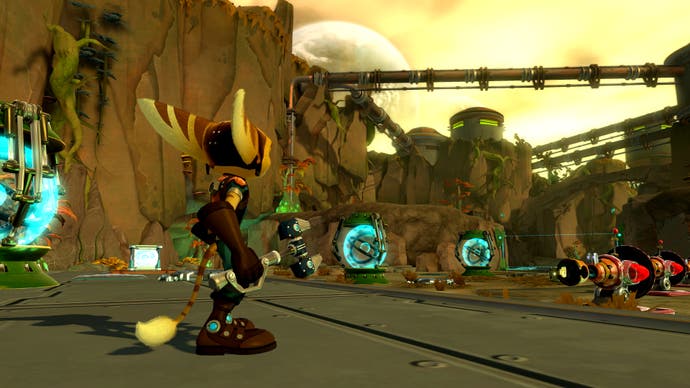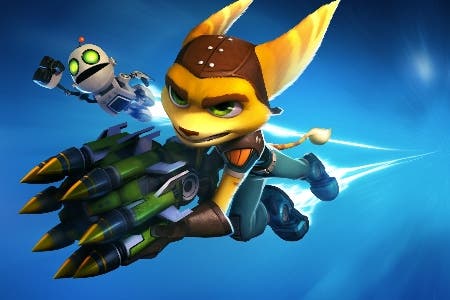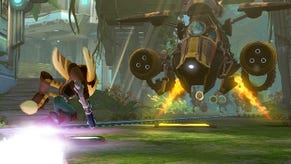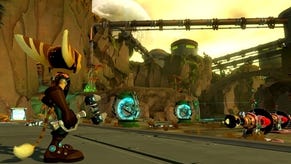Ratchet & Clank: QForce review
Time to bury the ratchet?
Nestled in amongst the studio logos and copyright messages as you boot up Ratchet & Clank: QForce is a logo proclaiming 2012 to be the 10th anniversary of the sci-fi odd couple. The series has averaged one game a year across its decade-long lifespan, with the clumsily titled QForce marking the 11th outing for the quick-witted lombax and his mechanical pal.
Most game series have run out of steam after reaching this milestone, with the sort of 3D platform romps that Ratchet and Clank inhabit proving especially susceptible to the rigours of age. Perhaps that's why Insomniac's most recent entries have felt a little... desperate. Between last year's limp and chaotic co-op scramble All 4 One and QForce's attempt to inject mob strategy into the series, it seems confidence in the characters' core appeal is at a low ebb. QForce is a platform game that's apparently terrified of being a platform game.
Instead, it's a tower defence hybrid, and a sadly clumsy one at that. Each level is now a self-contained maze with a mass of generators at one end. If the enemy destroys all of these, it's game over. Access to this area is down two linear pathways, along which are scattered fixed points where you can place turrets, mines and barriers. Periodically, waves of enemies start marching towards your position and you must repel them by any means necessary.

So far, so predictable. However, you need to be a bit more proactive than simply fortifying your choke points and waiting. In between attacks, you need to venture out into the level to accomplish a variety of tasks. Your main goal is to activate the key nodes needed to reboot the planetary defence systems for each world. Doing this means running a gauntlet of various enemy types and destroying a series of shields.
The problem is that you start each level without any weapons other than your trusty wrench, and so must also scout around the level seeking out weapon pods to gain access to such tools and gadgets as the Warmonger, Thundersmack and other familiar arsenal items from previous games.
You're also on the lookout for crates that can be smashed in order to earn the nuts and bolts required to purchase the various defences for your base. These accumulate slowly - a good foraging expedition generally nets around 5000 - and since the most effective turrets and barriers cost at least several thousand each, it takes several rounds to set up even a basic defensive line.
It's not as if these expensive defences are particularly robust. Barriers crumble quickly and turrets seem to take more damage than they can dish out. The inevitable result of this is a constant back-and-forth as you abandon assaults on enemy positions or the hunt for a new weapon pod in order to dash back to base - through often confusing layouts - in order to do the job of fighting back yourself. Even then, you'll find yourself rushing from one side of the base area to the other, covering both entry points and bashing crates to restock on ammo and health, rather than relying on your feeble automated defences.

The tower defence genre has always rested on a bedrock of frantic plate-spinning, but QForce takes it to a ludicrous extreme, spamming you with tough enemies, limiting your resources and generally making every inch of progress in the game's disappointingly thin story feel like more trouble than it's worth. This is a ferociously difficult game, but one that rarely feels like it's playing fair. Too often it seems to be punishing the player for stopping to think, exploring too far or simply trying something different.
If you're playing solo, that is. After the lukewarm reception that greeted All 4 One it's understandable that the co-op element has been downplayed for this entry, but that doesn't make it any less of a multiplayer game. With two players, either playing locally or online, things come into better focus. One can venture forth into the level while the other guards the base, or both can assault different enemy key nodes at the same time. More to the point, with two players in action accumulating currency, it's possible to stockpile bolts, establish a solid defensive line of turrets and engage with actual strategy rather than being constantly forced onto the back foot.
The game is more satisfying in co-op, but it still never really finds an enjoyable rhythm, the solo platforming and combat forever interrupted by the tower defence element rather than working in harmony. Third-person action and tower defence can work - see the superficially similar Orcs Must Die! - but QForce's clumsy genre patchwork feels more like an awkward attempt to latch onto a popular gameplay mechanic rather than an organic direction for the series to take. The steep in-game economy deters you from experimenting, the balancing between damage taken and dished out is all wrong and the core concept pulls in two directions at once to no great effect.
If the game has a saving grace, it's the competitive multiplayer, which unfolds with a pace and structure far more conducive to the strategic underpinnings of tower defence. Play is intimate - two against two is the biggest match type - and the maps are clearer, tighter and simply more fun to play in.

Matches are broken up into three rounds. In the first you race around the map, claiming key nodes for your side. Each generates a constant stream of currency to fund your building. That follows in the second phase, in which you not only spend your bolts on the expected defences, but on squads of aliens that will attack the opposing team. The final phase is the assault, and you're free to lead the charge or man the barricades as the occasion demands.
It's simple but effective, and it's baffling why some of these ideas are restricted to multiplayer. The use of key nodes to generate bolts is particularly useful, since that would solve many of the solo campaign's frustrations at a stroke, enabling the tower defence elements to stand up by themselves rather than becoming a frustrating grind.
But a grind it is, and that's a crushing disappointment given the Ratchet & Clank heritage. The series has taken a few wrong turns in its time, but always retained a clear sense of identity and a charming wit that saw it through its more ill-advised spin-offs. These are almost completely missing from QForce, a game which too often barely resembles the beloved classics it sprang from. Worst of all, Clank only appears in the gameplay if a second player joins in, meaning that those playing solo don't even get the benefit of the traditional banter that fans adore outside of the cut-scenes. Certainly, you could swap the character models for almost anything else and the 10-year lineage would be hard to spot.
The game always looks good, and it amuses sporadically, but there's no heart - and following on from the similarly scattershot All 4 One, it sets a worrying precedent. Ratchet and Clank are in danger of losing their way. Insomniac needs to regain confidence in its still-popular series and play to its strengths rather than chasing trends for the sake of change.














